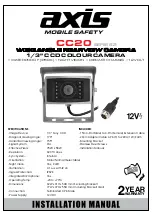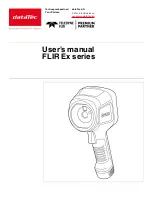
Fig. 16
Abb. 16
Fig. 17
Abb. 17
①
Pull out from here
②
Hinge
③
Harness cover
⑤
Hatch
④
Rear view
camera
①
Rear view camera
②
Hatch
③
Cord
②
Waterproof pad
Fig. 18
Abb. 18
①
Clamps
③
Rubber packing
④
Make a U-shaped loop in
the lead outside the rubber
packing to prevent rain-
water from flowing along
the lead into the interior
of the vehicle.
Connection <ENGLISH>
Note:
• This unit is for vehicles with a 12-volt battery and nega-
tive grounding. Before installing it in a recreational vehi-
cle, truck, or bus, check the battery voltage.
• To avoid shorts in the electrical system, be sure to discon-
nect the
battery cable before beginning installation.
• Refer to the owner’s manual for details on connecting the
other units, then make connections correctly.
• Secure the wiring with cable clamps or adhesive tape. To
protect the wiring, wrap adhesive tape around them where
they lie against metal parts.
• Route and secure all wiring so it cannot touch any mov-
ing parts, such as the gear shift, handbrake and seat rails.
Do not route wiring in places that get hot, such as near
the heater outlet. If the insulation of the wiring melts or
gets torn, there is a danger of the wiring short-circuiting
to the vehicle body.
• Do not shorten any leads.
• Never feed power to other equipment by cutting the insu-
lation of the power supply lead of the unit and tapping
into the lead. The current capacity of the lead will be
exceeded, causing over heating.
• When replacing the fuse, be sure to only use a fuse of the
rating prescribed on the fuse holder.
• To minimize noise locate the TV antenna cable, radio
antenna cable and RCA power supply cable as far away
from each other as possible.
• Connection to a TV with an RCA video input is possible,
but confirm whether the TV you use has a reverse gear
connection function.
• If this unit is installed in a vehicle that does not have an
ACC (accessory) position on the ignition switch, the red
lead of the unit should be connected to a terminal coupled
with ignition switch ON/OFF operations. If this is not
done, the vehicle battery may be drained when you are
away from the vehicle for several hours.
ACC ON
S
TA
RT
O
FF
ON
S
TA
RT
O
FF
ACC position
No ACC position
• Cords for this product and those for other products may
be different colors even if they have the same function.
When connecting this product to another product, refer to
the supplied manuals of both products and connect cords
that have the same function.
Connection sample (Fig. 14)
①
Power supply unit
②
Rear view camera connector
③
RCA power supply cable connector
④
Rear view camera
Video input jack
Connect to video input jack.
⑤
RCA pin
Accessory power supply
To electric terminal controlled by ignition
switch (12 V DC) ON/OFF.
⑥
Red
⑦
Fuse (1A)
Ground
To vehicle (metal) body.
⑧
Black
Cord installation (Fig. 15)
①
Clamps
②
Rear view camera
③
RCA power supply cable
④
Product with a video input jack
(Hideaway unit etc.)
⑤
Power supply unit
⑥
Made with a rasp etc.
⑦
Scuff plate
⑧
Clamp
⑨
Waterproof plate
Cord installation points (Fig. 16)
• When pulling the cord out of the car,
pull from the outer side of the hatch har-
ness cover and hinge.
①
Pull out from here
②
Hinge
③
Harness cover
④
Rear view camera
⑤
Hatch
After cord installation (Fig. 17, Fig. 18)
• Open and close the hatch door slowly
to confirm that the cord is not rubbing
against the rim of the door.
①
Rear view camera
②
Hatch
③
Cord
• When the rear view camera cord cannot
be pulled out from the lower side due to
the type of car.
As shown in the figure 18, bend the cord
into a U shape in front of the waterproof
pad, making sure that rain water cannot
enter the car by running down the cord.
①
Clamps
②
Waterproof pad
③
Rubber packing
④
Make a U-shaped loop in the lead outside
the rubber packing to prevent rainwater from
flowing along the lead into the interior of the
vehicle.
Power source ........................................... 14.4 V DC
(10.8 V to 15.1 V allowable)
Grounding system .............................. Negative type
Max. current consumption .......................... 120 mA
Output video ....................................... Mirror image
(for rear view confirmation)
Sensor ............................ 1/4-inch color CCD sensor
No. of pixels ........ 492 (vertical)
×
512 (horizontal)
(Total no. of pixels: 270 000,
effective no. of pixels roughly 250 000)
Lens ........................................................ Wide-angle,
focal length f = 1.53 mm, F value 2.8
Angle of view ................... Horizontal: approx. 135º
Vertical: approx. 100º
IR cutoff filter (special filter for vehicle mounting)
.................................................................. Provided
Iris system .......................................... Electronic iris
Scanning system ........................................ Interlace
Synchronizing system ....... Internal synchronization
Signal-to-noise ratio .......................... 40 dB or more
(at the recommended intensity of illumination)
Horizontal resolution ............ Approx. 300 TV lines
Illumination range .... Approx. 1.5 lux to 100 000 lux
Image output ...................................... 1 Vp-p (75 Ω)
Operation temperature range ........... –30ºC to +70ºC
+22ºF to +158ºF
Storage temperature range .............. –40ºC to +85ºC
–40ºF to +185ºF
Dimensions
Camera unit ... 27 (W)
×
27 (H)
×
26 (D) mm
1
(W)
×
1 (H)
×
1 (D) in.
Power supply unit
.................... 70 (W)
×
23 (H)
×
35 (D) mm
2-3/4
(W)
×
7/8 (H)
×
1-3/8 (D) in.
Weight
Camera unit ................................ 150 g (0.3 lbs)
(including the cable)
Power supply unit ...................... 160 g (0.4 lbs)
(including the power cord)
Note:
Specifications and the design are subject to possible
modification without prior notice due to improve-
ments.
Specifications <ENGLISH>


























